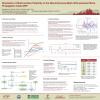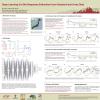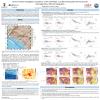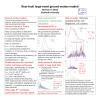Poster #212, Ground Motions
Ground motion prediction using ambient seismic noise on a large-N array in the LA basin
Poster Image:

Poster Presentation
2020 SCEC Annual Meeting, Poster #212, SCEC Contribution #10579 VIEW PDF
arthquakes as the ambient-field Green’s function encodes the basin structure.
In this study we perform an in-depth comparison between point source theoretical Green’s functions and the ambient-field Green’s function obtained from a dense, large-N nodal and broadband array in the greater Los Angeles area, the BASIN experiment. Using temporary and permanent stations located along the SAF as virtual sources and combining the nodal arrays with the SCSN stations, we compare all 9 components of the correlation tensor and focus on Love and Rayleigh wave properties.
The analysis informs numerical simulations of the seismic wavefield which uses a 3D velocity model via the AWP-ODC finite-difference solver. Confronted with the size of the large-N nodal array’s and permanent stations, we use Julia language, a high performance scripting language, and AWS cloud computing to process the N-squared cross-correlations. With 14 source stations located along the SAF and the dense spatial array covering more than 300 permanent and nodal receiver stations in the LA area, the calculation of all 9 components yields ~40,000 correlations. The dense coverage with station pairs in the area between downtown LA and the SAF is expected to dramatically improve our knowledge of the basin structure and therefore ground motion prediction.
We consider the cloud computing framework and high performance dynamic computing languages like Julia the next direction for ambient noise computation, and present this methodology alongside fundamental descriptions of the 3D wavefield using the empirical ambient-field and theoretical Green’s function.
SHOW MORE
In this study we perform an in-depth comparison between point source theoretical Green’s functions and the ambient-field Green’s function obtained from a dense, large-N nodal and broadband array in the greater Los Angeles area, the BASIN experiment. Using temporary and permanent stations located along the SAF as virtual sources and combining the nodal arrays with the SCSN stations, we compare all 9 components of the correlation tensor and focus on Love and Rayleigh wave properties.
The analysis informs numerical simulations of the seismic wavefield which uses a 3D velocity model via the AWP-ODC finite-difference solver. Confronted with the size of the large-N nodal array’s and permanent stations, we use Julia language, a high performance scripting language, and AWS cloud computing to process the N-squared cross-correlations. With 14 source stations located along the SAF and the dense spatial array covering more than 300 permanent and nodal receiver stations in the LA area, the calculation of all 9 components yields ~40,000 correlations. The dense coverage with station pairs in the area between downtown LA and the SAF is expected to dramatically improve our knowledge of the basin structure and therefore ground motion prediction.
We consider the cloud computing framework and high performance dynamic computing languages like Julia the next direction for ambient noise computation, and present this methodology alongside fundamental descriptions of the 3D wavefield using the empirical ambient-field and theoretical Green’s function.
SHOW MORE

























































